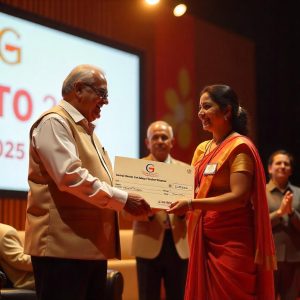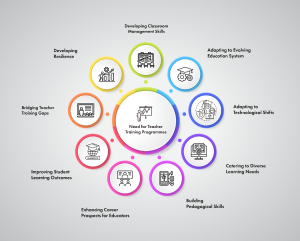The role of educators in today’s world extends beyond delivering lectures and grading papers. As an educator, I have observed up close, how expectations from teachers have transformed. Today’s educator is a mentor, a problem solver, and a leader who shapes the next generation. It is essential to master 21st century teaching skills to meet the demands of a fast-changing, interconnected world, where adaptability, innovation, and empathy are key.
Here are the top 10 essential skills that empower educators to excel and create meaningful impacts in the classroom.
1. Mastering 21st Century Teaching Skills
Today, teachers must move beyond traditional teaching methods to prepare students for the future. The focus is no longer solely on academic content, but also on equipping learners with essential skills to succeed in a globalised and digital world. Central to this approach are the 4Cs — Critical thinking, Communication, Collaboration, and Creativity — skills that form the foundation of effective 21st century teaching.
While these skills are not new to educational or business contexts, their application in K-12 schools has evolved significantly. Historically, creativity, critical thinking, communication, and collaboration have been integral of human progress (Rotherham & Willingham, 2009; Silva, 2009). However, the way we teach and develop these skills today is evolving and has become more integrated, as now there is a strong emphasis on technology and innovation.
To cultivate these skills, educators must adapt their approaches by integrating modern tools and methods to support learners in navigating the complexities of the 21st century. We, educators, need to focus on both content mastery and the development of these critical skills. Only then can we, better prepare students for challenges and opportunities of the future.
2. Building Digital Literacy for Teachers
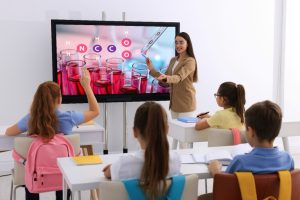
Technology in the classroom is no longer optional. Digital literacy for teachers is vital to harness the power of technological tools such as learning management systems (LMS), virtual learning platforms, apps, and collaborative software. Teachers must be able to model responsible tech use while ensuring students develop the digital skills they need to navigate the digital world confidently.
Educators must adapt their strategies to integrate technology and meet the changing learning needs of today’s students. The way students learn has shifted as technology empowers them to seek information beyond the traditional classroom. Students are now increasingly proactive in learning through online content and personal networks. They interact with multiple forms of media, and oftentimes find traditional teaching methods insufficient. Education needs to be more personalised, social, and engaging, that offers instant gratification and caters to both ‘digital natives’ and ‘digital immigrants’ (Prensky, 2001).
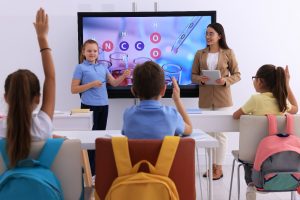
3. Adapting to Change
Adaptability in teaching is critical as educators face evolving curricula, technological advancements, and diverse student needs. Teachers can adapt to new technologies, like interactive whiteboards or learning management systems by participating in training sessions and integrating these tools into their lessons. For example, creating virtual quizzes or online discussion forums enhances learning while modeling openness to new methods.
Flexibility is key! Remember how crucial flexibility was during the COVID lockdowns, with the sudden shift to remote learning. Teachers who quickly adjusted their lesson plans, embraced digital tools like video conferencing, and encouraged collaboration to ensure continuity in education.
Adapting to change needs a growth mindset in the classroom. Teachers should be able to share their experiences with change and how they are learning new methods to use in the classroom. This models resilience and shows students that challenges are opportunities for growth. Teachers must embrace flexibility, modeling resilience and open-mindedness to prepare students for the uncertainties of the future.
4. Employing Creative Teaching Methods

Engaging students requires creative teaching methods and innovative teaching strategies. Some examples of creative teaching methods are gamification and project-based learning. These approaches spark curiosity and encourage active participation. Educators can inspire students to think outside the box and help them develop solutions to complex problems by adopting modern teaching techniques.
Gamification enhances learning when you can integrate game-like elements in your lessons. You may be already doing this by including points, badges, and challenges to motivate and engage students. Plan rewards for completing tasks like solving math puzzles or achieving reading milestones, this would turn routine learning into exciting achievements. Create competitive quizzes on online platforms so that students deeply engage in core subjects making both teaching and learning enjoyable while fostering teamwork, persistence, and a sense of accomplishment.
In project-based learning students are encouraged to apply their knowledge to real-world scenarios. This promotes critical thinking and problem solving. Create a space for younger students to experiment hands-on and the opportunity for older students to work on interdisciplinary projects, you will see that students will be able to connect academic concepts with practical applications, while building skills like communication and creativity.
The idea is to create and engaging and purposeful classroom environment, empowering students to take ownership of their learning and develop essential skills for the future.
5. Fostering Critical Thinking in Education
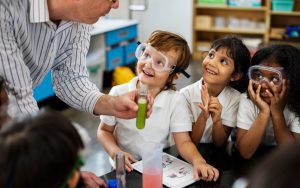
Critical thinking is a cornerstone of student success in the 21st century. Teachers need to guide students to analyse, evaluate, and synthesise information, empowering them to solve problems independently. Problem-solving in education fosters deeper learning and prepares students for real world challenges.
In the foundational years (K – 5), when teaching subjects like Environmental Science (EVS) and introducing basic scientific concepts, young students should be encouraged to predict the outcomes in simple experiments, such as floating and sinking, and express their reasoning. This helps develop their ability to analyse and draw conclusions.
In the middle years (6–8), students should be able to engage in more complex tasks. For example, in history they may compare different perspectives on an event and assess the credibility of sources. In math, they could be asked to explain their problem-solving process, which helps deepen their understanding. By participating in debates, analysing case studies, and working on real-world projects, students learn to approach problems from multiple angles. This helps in strengthening their critical thinking and problem-solving skills.
6. Excelling in Classroom Management Skills
Classroom management skills are the backbone of a conducive learning environment. Balancing authority with empathy ensures that students feel safe, respected, and engaged. It is effectual to establish clear rules and expectations at the beginning of the academic year. By consistently enforcing these rules, it demonstrates fairness and builds trust. An example of how we can do this is by using visual behaviour charts for younger students, that allows them to track progress and understand the consequences of their actions in a tangible way.
Effective classroom management also supports social-emotional learning. When students are emotionally secure and engaged, they are better able to focus on learning and development. Some teachers talk about how doing a “Check-in Circle” at the start of the day is very helpful. Here, students get a chance to share their feelings or discuss topics like gratitude and kindness. Such practices help students build self-awareness and empathy, contributing to a more harmonious classroom. Such structured group activities keep students engaged, encourage collaboration and teamwork while reducing behavioural issues.
7. Effective Communication for Teachers

Effective communication for teachers is more than just delivering lessons; it is about creating a space for students to be heard, valued, and understood. Encourage students to ask questions and share their thoughts. This helps them build their confidence, deepens engagement, and enhances understanding. Use clear, child-friendly language to explain complex concepts to ensure clarity in communication and helps reduce frustration.
Effective communication is also pivotal for collaboration. Regular updates to parents build strong partnerships, ensuring they can support their child’s learning. Collaborating with colleagues on cross-curricular projects or sharing best practices enhances teamwork and enriches the teaching learning experience.
Effective communication helps in managing classroom dynamics. Calm discussions with students about behavioural issues, paired with non-verbal cues like eye contact and positive gestures, de-escalate tensions and creates connections. It helps resolve conflicts and builds respect. Good communication skills underpin collaboration in education, enabling teacher to work seamlessly with peers, parents, and administrators to achieve shared goals.
8. Leading with Purpose
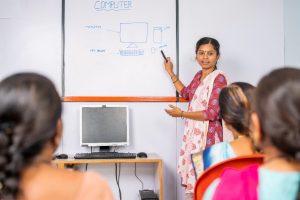
Leadership in teaching is about inspiring students, mentoring colleagues, and influencing positive change in the education system. Great educators are proactive, take initiative, implement innovative teaching strategies, and guide their communities toward a shared vision of success.
Arthur Levine (2006) rightly points out that “The challenge facing education schools is not to do a better job at what they are already doing, but to do a fundamentally different job. They are now in the business of preparing educators for a new world.” There is a need for transformation in teacher preparation programs. Levine emphasises that schools of education cannot simply improve existing methods but must completely rethink how they prepare future educators. The traditional approaches are no longer sufficient in preparing teachers for the challenges of a rapidly changing world. Educators need to be equipped not only with subject knowledge but also with the ability to navigate technological advances, diverse learning environments, and the increasing demand for personalised learning
This shift calls for teaching training programs to redefine their roles — moving from simply teaching pedagogical theories to actively shaping leaders who can adapt, innovate, and prepare students for a tech-driven, globalized future. Leadership in teaching is about preparing educators who can embrace change, lead with vision, and positively impact the future of education.
9. Practicing Mindfulness for Teachers

Teaching can be stressful! Juggling lesson planning, grading, classroom management, and communicating with parents can be overwhelming, but mindfulness for teachers and stress management in education are essential for maintaining balance. Mindfulness is essential for educators to manage stress, improve focus, and create a calm, supportive classroom environment. This benefits students, who often mirror the emotional energy of teachers.
Make time for yourself to practice some mindfulness techniques, such as short meditations- two minutes guided breathing before a class or a moment of quiet reflection after lunch. It will help you approach your day with clarity and composure. Teachers who stay calm during tense moments model emotional regulation for students. It helps to create a more focused and peaceful learning atmosphere, enhancing students’ self-awareness and stress management.
Mindfulness also deepens teacher-student connections. Take the time to truly listen to students’ concerns. Create a supportive environment where students feels respected and valued. By integrating mindfulness into your daily routine, you can navigate challenges more effectively while cultivating a calm and harmonious classroom that benefits both yourself and your students.
10. Committing to Lifelong Learning for Educators

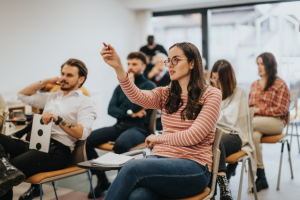
Professional development for teachers is crucial in staying relevant and effective. Whether it is through workshops, certifications, diplomas, degrees or exploring the latest innovative teaching strategies, educators must commit to lifelong learning. By continually growing, educators model the value of education for their students and remain in the forefront of their field.
Continuous improvement represents a growth mindset and the willingness to commit to revisiting the process over time, reviewing and adjusting what works and what does not. At the least, any implementation effort should include the following continuous improvement steps:
- Clearly identify measurable goals,
- Track progress regularly against these goals,
- Communicate progress to all stakeholders, and
- Engage all participants in refining and improving success over time.
Why These Skills Matter
The 21st century is defined by its rapid technological advances, complex societal challenges, and cultural diversity. Educators must embrace not only essential educator skills listed above but also develop a mindset of continuous improvement, to prepare students for this world.
These skills enable teachers to:
- Integrate and adapt to technology in the classroom.
- Foster critical and creative thinking.
- Build cultural competence and create inclusive spaces in education.
- Promote innovation, adaptability, and collaboration among students.
By mastering these skills, educators don’t just prepare students for exams—they prepare them for life. The classroom is where students observe their teachers modeling key skills. If teachers are unable to articulate effective teaching practices themselves, they cannot model these practices for their students. This challenge is critical not only for training observers but also for providing meaningful feedback and professional development for teachers.
As educators, our mission is clear: lead by example, embrace change, and use our skills to inspire future generations. The impact we make today will shape the innovators, leaders, and thinkers of tomorrow. It is imperative for teacher educators to enhance their own 21st century skills to transfer this skill set to their students (Rust & Bergey, 2014; White & Chant, 2014). Let us seize this incredible responsibility with passion and purpose!
References:
Kim, S., Raza, M., & Seidman, E. (2019). Improving 21st-century teaching skills: The key to effective 21st-century learners. Research in Comparative and International Education, 14(1), 99-117.
Levine, A. (2006). Educating school teachers. Education Schools Project.
Prensky, M., & Berry, B. D. (2001). Do they really think differently. On the horizon, 9(6), 1-9.Prensky, 2001
Rotherham, A. J., & Willingham, D. (2009). 21st century. Educational leadership, 67(1), 16-21.
Rust, F., & Bergey, N. (2014). Developing action-oriented knowledge among preservice teachers. Teacher Education Quarterly, 41(1), 63-83.
Silva, E. (2009). Measuring skills for 21st-century learning. Phi delta kappan, 90(9), 630-634.
Urbani, J. M., Roshandel, S., Michaels, R., & Truesdell, E. (2017). Developing and modeling 21st-century skills with preservice teachers. Teacher Education Quarterly, 44(4), 27-50.
White, J. W., & Chant, R. H. (2014). Challenging Idealism: Pre-Service Teachers’ Core Beliefs Before, During, and after an Extended Field-Based Experience. Teacher Education Quarterly, 41(2), 73-92.
Author – Charlotte Sen, Chief Academic Officer

